Demand-Side Management for Improvement of the Power Quality in Smart Homes Using Non-Intrusive Identification of Appliance Usage Patterns with the True Power Factor
Abstract
:1. Introduction
1.1. Perspectives on Demand-Side Management
1.2. Non-Intrusive Monitoring of the Usage of Appliances
1.3. Feature Selection for NILM
1.4. The Major Contributions and Organization of the Article
- TPF measurement of real-world LPCEAs as per the IEEE 1459-2010 standard [18] by using the four-term minimal sidelobe cosine window (4MSCW)-based enhanced dual-spectrum line interpolated FFT (EDSLIFFT).
- Development of a virtual instrumentation-based measurement system for TPF measurements.
- Recommendation of appliance patterns for improvement of the TPF and DSM by using a lookup table in order to improve the utilization indexes of consumers.
2. Measurement of the TPF Using the Four-Term MSCW-Based EDSLIFFT
2.1. Overview of the Four-Term MSCW
2.2. Processing with the 4MSCW-Based EDSLIFFT Algorithm
2.3. TPF Measurement as per the IEEE 1459-2010 Standard
3. Real-Time (RT) Measurement of the TPF
4. RT Results
5. Discussion
5.1. Analysis of the Results
- The harmonics are non-additive, and the cumulative TPF takes both the inductive and capacitive factors of various appliance combinations into consideration.
- Individual PFs are of no consequence, and the TPF is the value to consider in order to compare the impacts of appliance usage patterns with the impacts of individual appliances, as in our article. Therefore, the TPFs of appliance combinations are nonlinear, making the appliance patterns in use uniquely identifiable.
- The TPF can be improved by selecting alternative appliance patterns, as suggested in Table 4.
- Highly nonlinear appliances, such as CFLs, SMPSs, and their combinations, consume more reactive power, which results in a poor TPF.
- The standard deviation of the TPF from the experimental results was 0.1271 for the demand, and it was reduced to 0.099 according to the recommended consumer responses. Thus, the consumer utilization index improved, as illustrated in Table 4, and the quality of the power was enhanced.
- According to the results, it is necessary to adopt current harmonic mitigation devices, such as active power filters and PF correction devices in LVDSs, in order to minimize the malfunctioning of the utility equipment, such as failures of the transformers, false tripping of the circuit breakers, etc., as well as to safeguard LPCEAs from overheating.
- It is necessary to develop smart energy meters in order to measure the THD and TPF and to recommend PQ-sensitive measures, with a provision in the power tariffs for better consumer behavior.
5.2. Future Research
- A smart home may have very sophisticated appliances that could be programmed and operated remotely or controlled through a mobile application. How demand-response systems can take advantage of appropriate communication is of practical interest to explore.
- The physical/thermal characteristics of electronic appliances may change over time and may, in turn, change the THD and TPF values. The accommodation of these adaptabilities in the demand-side management systems must be considered.
- The compensation of the reactive power must be studied so that a power factor at unity can be achieved at all times and all nodes in a distribution system.
6. Conclusions
Author Contributions
Funding
Acknowledgments
Conflicts of Interest
Nomenclature
| n | Sample index |
| m | Window item index |
| M | Maximum window item number |
| h | Harmonic order |
| hmax | Maximum harmonic order |
| ah | Minimal sidelobe cosine window (MSCW) coefficients |
| W | Four-term MSCW function |
| N | Total number of samples |
| Ts | Sampling time |
| t | Time period |
| Ah | Amplitude of the hth harmonic component |
| fh | Frequency of the hth harmonic component |
| Phase of the hth harmonic component | |
| k | Four-term MSCW sample points (k = 0, 1, …, N − 1) |
| kh | Division factor of signal frequency |
| fs | Sampling frequency |
| lh | Integer value of greatest spectral line |
| Fraction part of greatest spectral line | |
| lh1 | Spectral line 1 representing the hth harmonic amplitude |
| lh1 | Spectral line 2 representing the hth harmonic amplitude |
| I | Spectral line peak index location value |
| y1 | Amplitude of the spectral line 1 |
| y2 | Amplitude of the spectral line 2 |
| Symmetrical coefficient 1 | |
| β | Symmetrical coefficient 2 |
| VRMS | Total input voltage RMS value |
| IRMS | Total load current RMS value |
| V1RMS | Input fundamental Voltage RMS value |
| VhRMS | hth order harmonic voltage RMS value |
| I1RMS | Load fundamental current RMS value |
| IhRMS | hth order harmonic load current RMS value |
| P | Active power consumed by the LPCEAs |
| Q | Reactive power consumed by the LPCEAs |
| Fundamental voltage phase angle | |
| Fundamental load current phase angle | |
| hth order harmonic voltage phase angle | |
| hth order harmonic load current phase angle | |
| VHRMS | Summation of all of the harmonic voltages |
| IHRMS | Summation of all of the harmonic currents |
| S | Apparent power |
| S1 | Fundamental apparent power component |
| SN | Non-fundamental apparent power component |
| D1 | Current distortion power |
| DV | Voltage distortion power |
| SH | Harmonic apparent power |
| THDV | Voltage total harmonic distortion |
| THDI | Current total harmonic distortion |
Abbreviations
| CEA | Central Electricity Authority |
| CFL | Compact fluorescent lamp |
| c-RIO | Compact reconfigurable input–output |
| DF | Distortion factor |
| DPF | Displacement power factor |
| DR | Demand response |
| DSM | Demand-side management |
| DSICOMs | Distribution companies |
| EDSLIFFT | Enhanced dual-spectrum line interpolated FFT |
| FFT | Fast Fourier transform |
| FPGA | Field-programmable gate array |
| IEEE | Institute of Electrical and Electronics Engineers |
| LED | Light-emitting diode |
| LPCEA | Low-power consumer electronic appliance |
| LVDS | Low-voltage distribution system |
| MSCW | Minimal sidelobe cosine window |
| NI | National Instruments |
| NILM | Non-intrusive load monitoring |
| PC | Personal computer |
| PCC | Point of common coupling |
| PF | Power factor |
| PQ | Power quality |
| RMS | Root mean square |
| RT | Real time |
| SDG 7 | Sustainable Development Goal 7 |
| SMPS | Switch-mode power supply |
| THD | Total harmonic distortion |
| TPF | True power factor |
References
- Rahman, M.A.; Islam, R.; Sharif, K.F.; Aziz, T. Developing demand side management program for commercial customers: A case study. In Proceedings of the 2016 3rd International Conference on Electrical Engineering and Information Communication Technology (ICEEICT), Dhaka, Bangladesh, 22–24 September 2016; IEEE: Piscataway, NJ, USA, 2016; pp. 1–6. [Google Scholar]
- Srikanth, R. India’s sustainable development goals–glide path for India’s power sector. Energy Policy 2018, 123, 325–336. [Google Scholar] [CrossRef]
- Hazra, S.; Bhukta, A. Sustainable Development Goals. An Indian Perspective, 1st ed.; Springer Nature: Cham, Switzerland, 2020; pp. 107–127. [Google Scholar]
- Verma, P.; Patel, N.; Nair, N.-K.C. Demand side management perspective on the interaction between a non-ideal grid and residential LED lamps. Sustain. Energy Technol. Assess. 2017, 23, 93–103. [Google Scholar] [CrossRef]
- Devarapalli, H.P.; Dhanikonda, V.S.S.S.S.; Gunturi, S.B. Non-Intrusive Identification of Load Patterns in Smart Homes Using Percentage Total Harmonic Distortion. Energies 2020, 13, 4628. [Google Scholar] [CrossRef]
- Oruganti, V.S.R.V.; Bubshait, A.S.; Dhanikonda, V.S.S.S.S.; Simões, M.G. Real-time control of hybrid active power filter using conservative power theory in industrial power system. IET Power Electron. 2017, 10, 196–207. [Google Scholar] [CrossRef]
- Jimenez, Y.; Cortes, J.; Duarte, C.; Petit, J.; Carrillo, G. Non-intrusive discriminant analysis of loads based on power quality data. In Proceedings of the 2019 IEEE Workshop on Power Electronics and Power Quality Applications (PEPQA), Manizales, Colombia, 30–31 May 2019; IEEE: Piscataway, NJ, USA, 2019; pp. 1–5. [Google Scholar]
- Francisco, C. Harmonics, Power Systems, and Smart Grids, 2nd ed.; CRC Press: Boca Raton, FL, USA, 2015; pp. 1–278. [Google Scholar]
- Oruganti, V.S.R.V.; Dhanikonda, V.S.S.S.S.; Simões, M.G. Scalable single-phase multi-functional inverter for integration of rooftop solar-PV to low-voltage ideal and weak utility grid. Electronics 2019, 8, 302. [Google Scholar] [CrossRef] [Green Version]
- Mageed, H.; Nada, A.S.; Abu-Zaid, S.; Eldeen, R.S.S. Effects of waveforms distortion for household appliances on power quality. MAPAN 2019, 34, 559–572. [Google Scholar] [CrossRef]
- da Silva, R.P.B.; Quadros, R.; Shaker, H.R.; da Silva, L.C.P. Effects of mixed electronic loads on the electrical energy systems considering different loading conditions with focus on power quality and billing issues. Appl. Energy 2020, 277, 115558. [Google Scholar] [CrossRef]
- da Silva, R.P.B.; Quadros, R.; Shaker, H.R.; da Silva, L.C.P. A Mixed of Nonlinear Loads and their Effects on the Electrical Energy Billing. In Proceedings of the 2020 IEEE 8th International Conference on Smart Energy Grid Engineering (SEGE), Oshawa, ON, Canada, 12–14 August 2020; IEEE: Piscataway, NJ, USA, 2020; pp. 116–120. [Google Scholar]
- da Silva, R.P.B.; Quadros, R.; Shaker, H.R.; da Silva, L.C.P. Harmonic Interaction among Electronic Loads and Its Effects on the Electrical Quantities and Billing: Case Study with Lighting Devices. In Proceedings of the 2020 7th International Conference on Electrical and Electronics Engineering (ICEEE), Antalya, Turkey, 14–16 April 2020; IEEE: Piscataway, NJ, USA, 2020; pp. 53–60. [Google Scholar]
- Ruano, A.; Hernandez, A.; Ureña, J.; Ruano, M.; Garcia, J. NILM techniques for intelligent home energy management and ambient assisted living: A review. Energies 2019, 12, 2203. [Google Scholar] [CrossRef] [Green Version]
- Yang, H.; Xue, Y.; Liu, S.; Gao, B.; Shu, Y.; Xu, Y.; Wang, J. A Judging Method of Electric Larceny in the Guise of Saving Electrical Energy. Application of Intelligent Systems in Multi-modal Information Analytics. MMIA 2019. In Advances in Intelligent Systems and Computing; Sugumaran, V., Xu, Z., Shankar, P., Zhou, H., Eds.; Springer: Cham, Switzerland, 2020; Volume 929, pp. 1029–1037. [Google Scholar]
- Gopinath, R.; Kumar, M.; Joshua, C.P.C.; Srinivas, K. Energy management using non-intrusive load monitoring techniques-State-of-the-art and future research directions. Sustain. Cities Soc. 2020, 62, 102411. [Google Scholar] [CrossRef]
- Dlamini, F.M.; Nicolae, D.V. An approach to quantify the technical impact of power quality in medium voltage distribution systems. In Proceedings of the 2016 IEEE International Power Electronics and Motion Control Conference (PEMC), Varna, Bulgaria, 25–28 September 2016; IEEE: Piscataway, NJ, USA, 2016; pp. 315–321. [Google Scholar]
- IEEE. Standard Definitions for the Measurement of Electric Power Quantities under Sinusoidal, Nonsinusoidal, Balanced, or Unbalanced Conditions. In IEEE Std. 1459–2010 (Revision of IEEE Std. 1459–2000); IEEE: New York, NY, USA, 2010. [Google Scholar]
- Oruganti, V.S.R.V.; Dhanikonda, V.S.S.S.S.; Paredes, H.K.M.; Simões, M.G. Enhanced Dual-Spectrum Line Interpolated FFT with Four-Term Minimal Sidelobe Cosine Window for Real-Time Harmonic Estimation in Synchrophasor Smart-Grid Technology. Electronics 2019, 8, 191. [Google Scholar] [CrossRef] [Green Version]
- Varaprasad, O.V.S.R.; Sarma, D.S.; Panda, R.K. Advanced windowed interpolated FFT algorithms for harmonic analysis of electrical power system. In Proceedings of the 2014 Eighteenth National Power Systems Conference (NPSC), Guwahati, India, 18–20 December 2014; IEEE: Piscataway, NJ, USA, 2014; pp. 1–6. [Google Scholar]
- IEEE. Recommended Practice for Monitoring Electric Power Quality. In IEEE Std. 1159–2019 (Revision of IEEE Std. 1159–2009); IEEE: New York, NY, USA, 2014. [Google Scholar]
- IEC 61000 4–30 Electromagnetic Compatibility (EMC)—Part 4–30: Testing and Measurement Techniques—Power Quality Measurement Methods; International Electrotechnical Commission: Geneva, Switzerland, 2015.
- User Manual, NI cRIO-9082. Available online: http://www.ni.com/pdf/manuals/376904a_03.pdf (accessed on 16 June 2021).
- Operating Instructions and Specifications, NI 9225. Available online: https://www.ni.com/pdf/manuals/374707e.pdf (accessed on 16 June 2021).
- Operating Instructions and Specifications, NI 9227. Available online: https://www.ni.com/pdf/manuals/375101e.pdf (accessed on 16 June 2021).
- IEEE. Recommended practices and requirements for harmonic control in electric power systems. In IEEE Std. 519–2014 (Revision of IEEE Std. 519–1992); IEEE: New York, NY, USA, 2014. [Google Scholar]


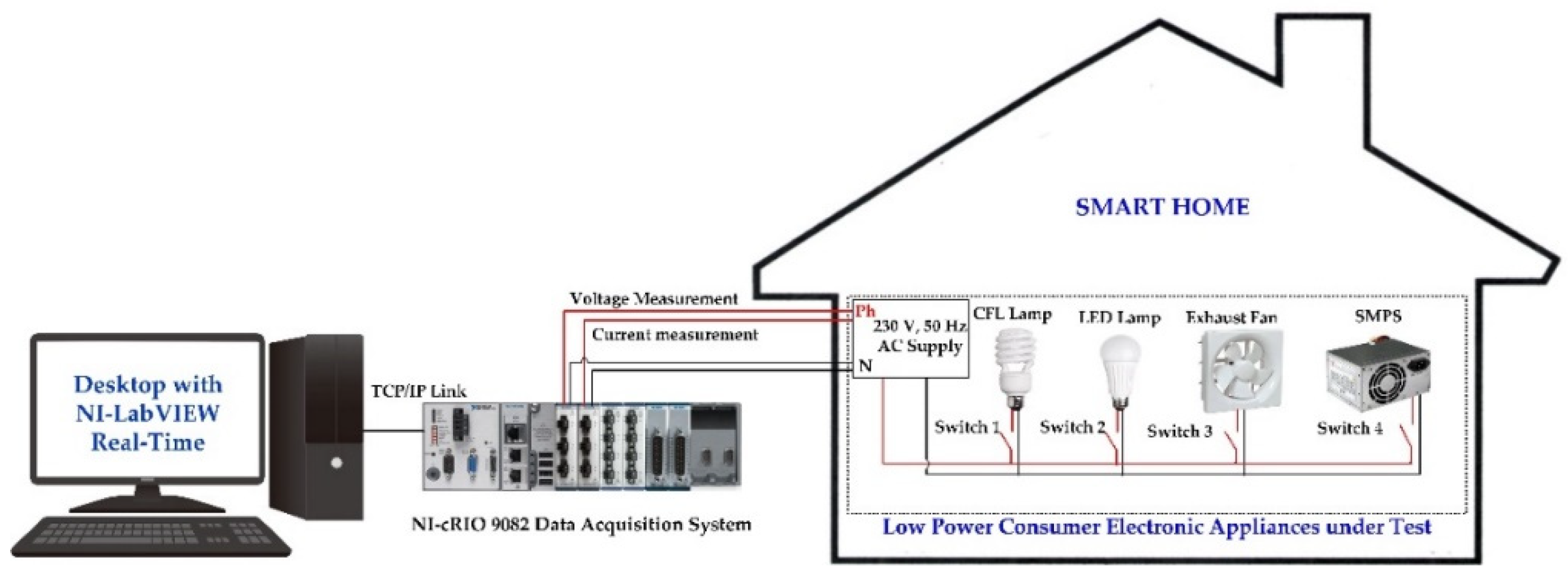
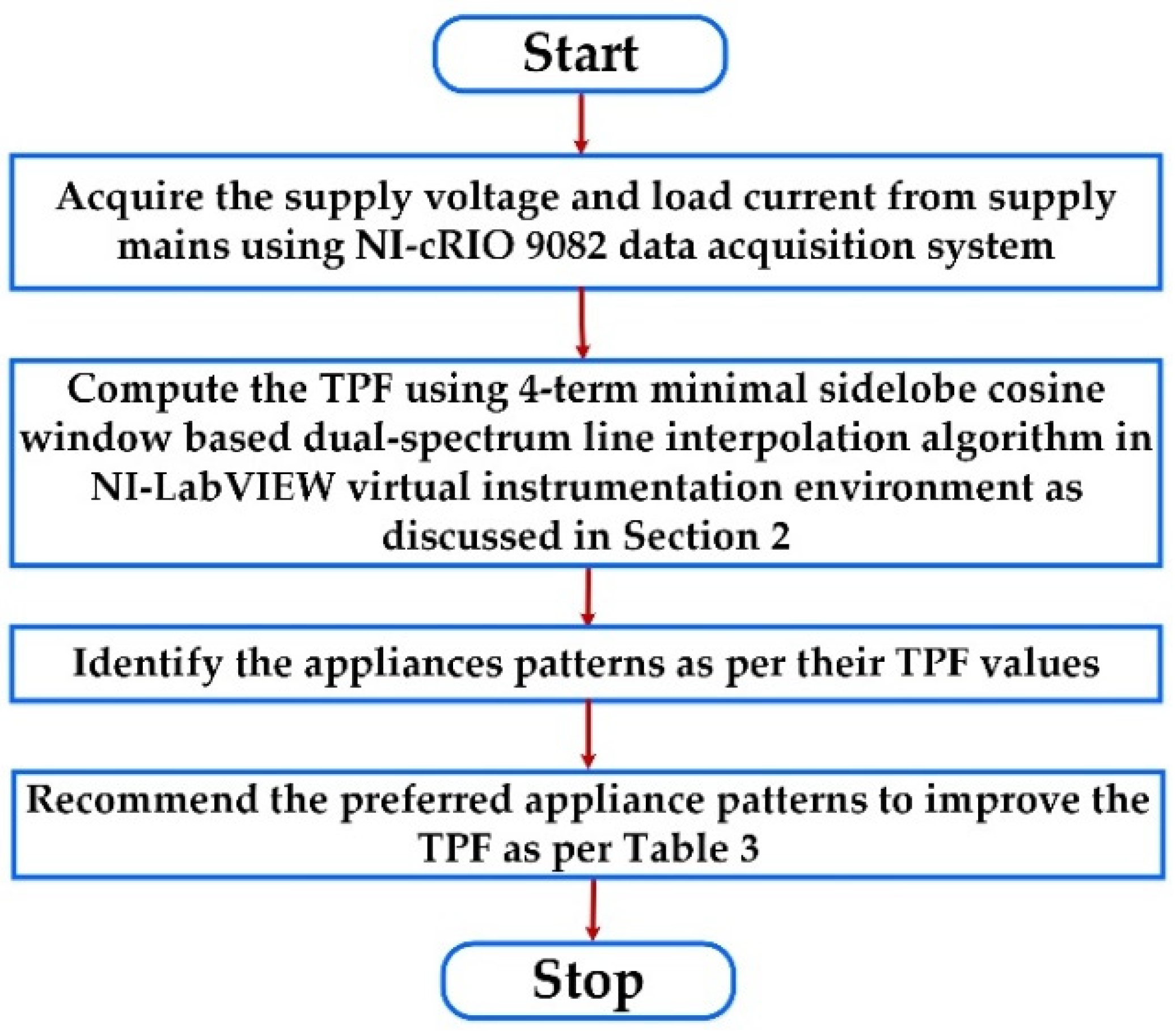
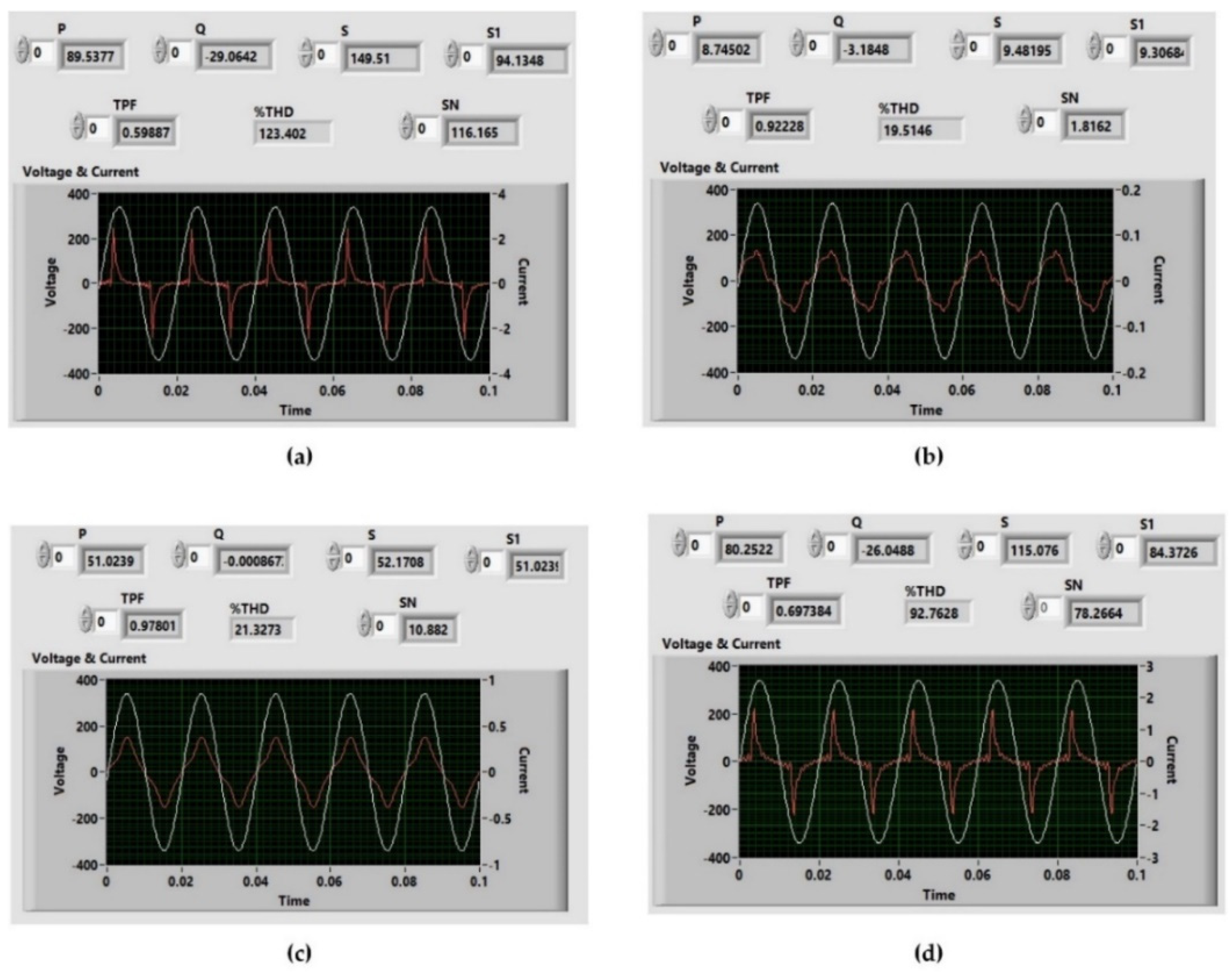
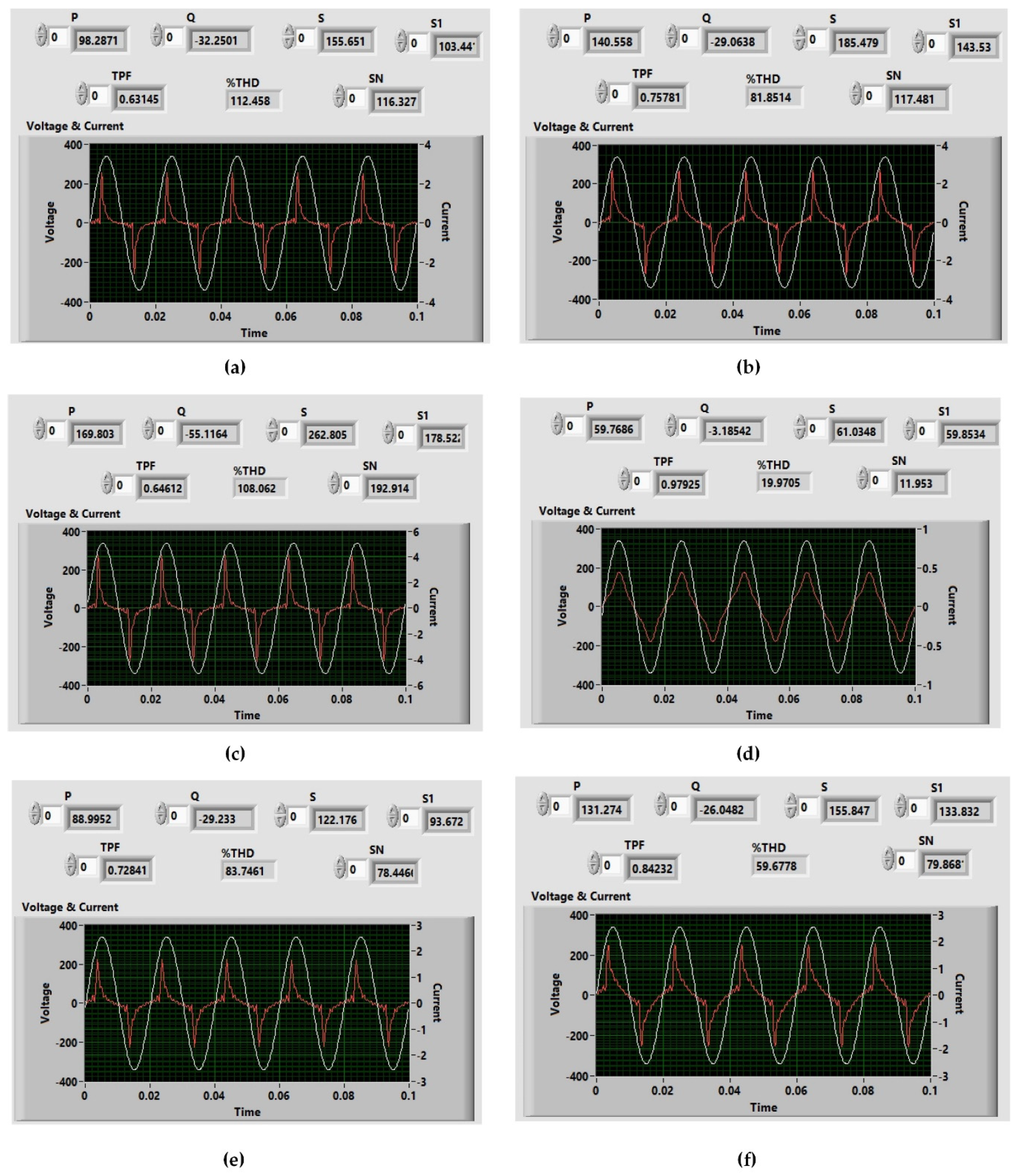
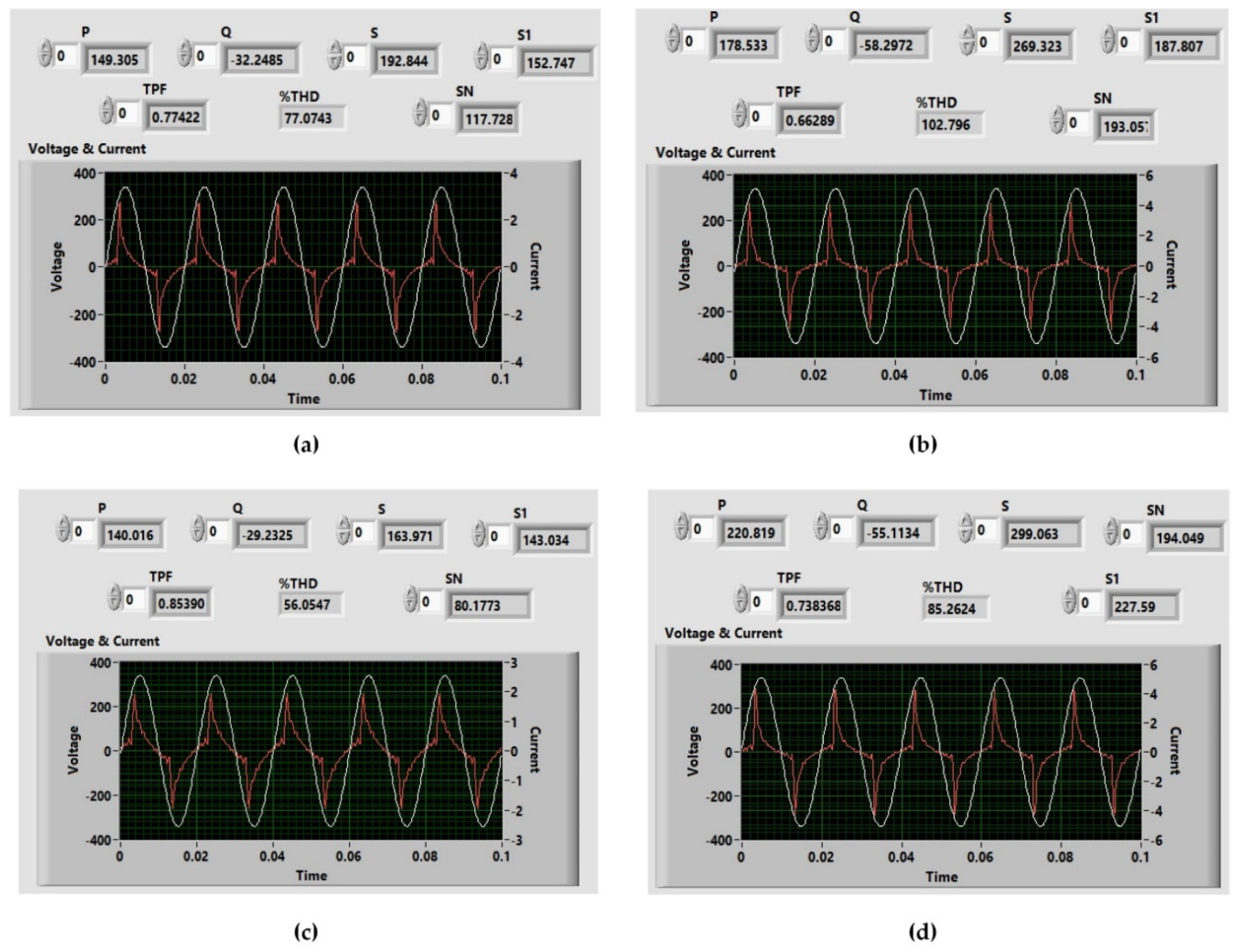
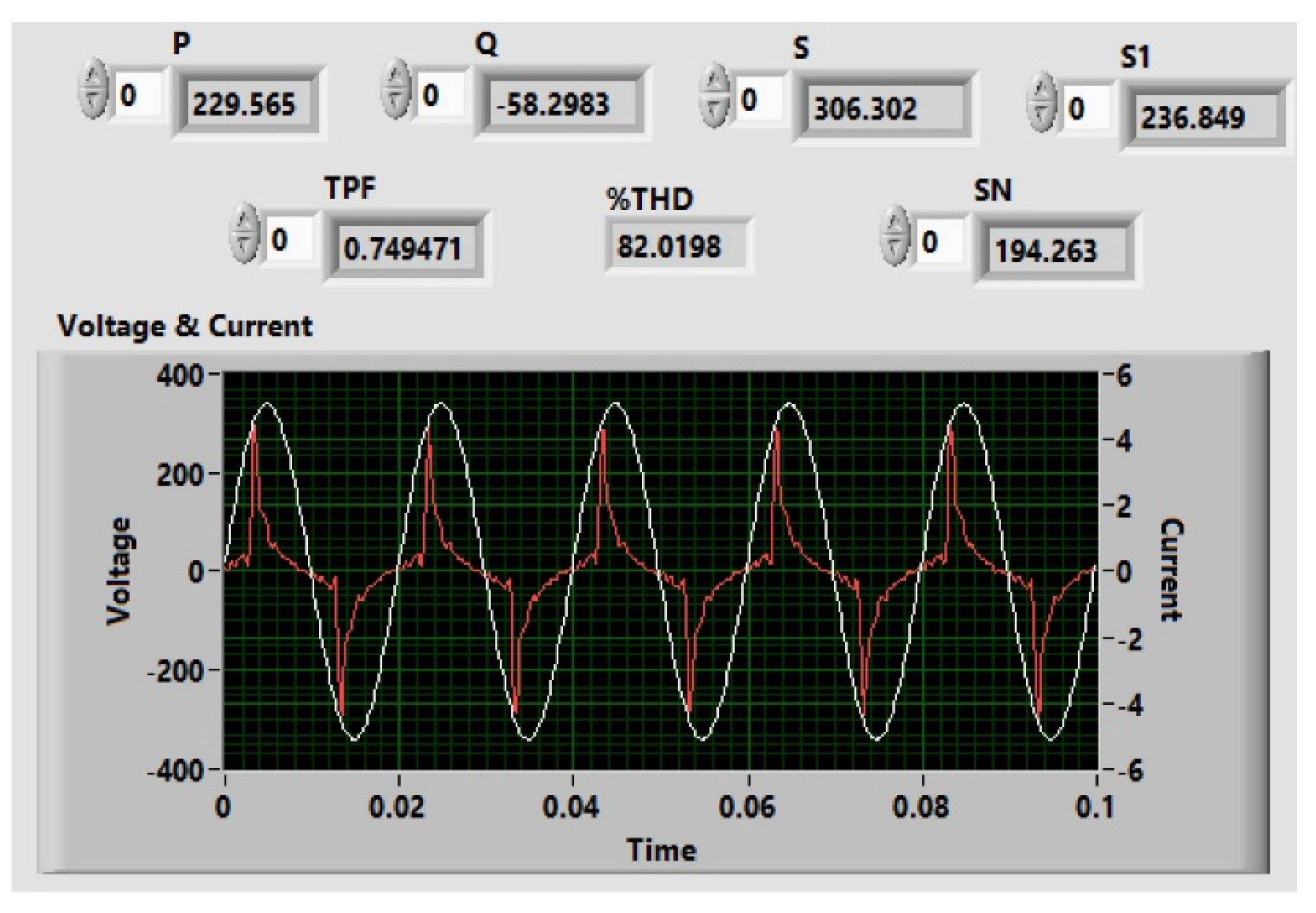
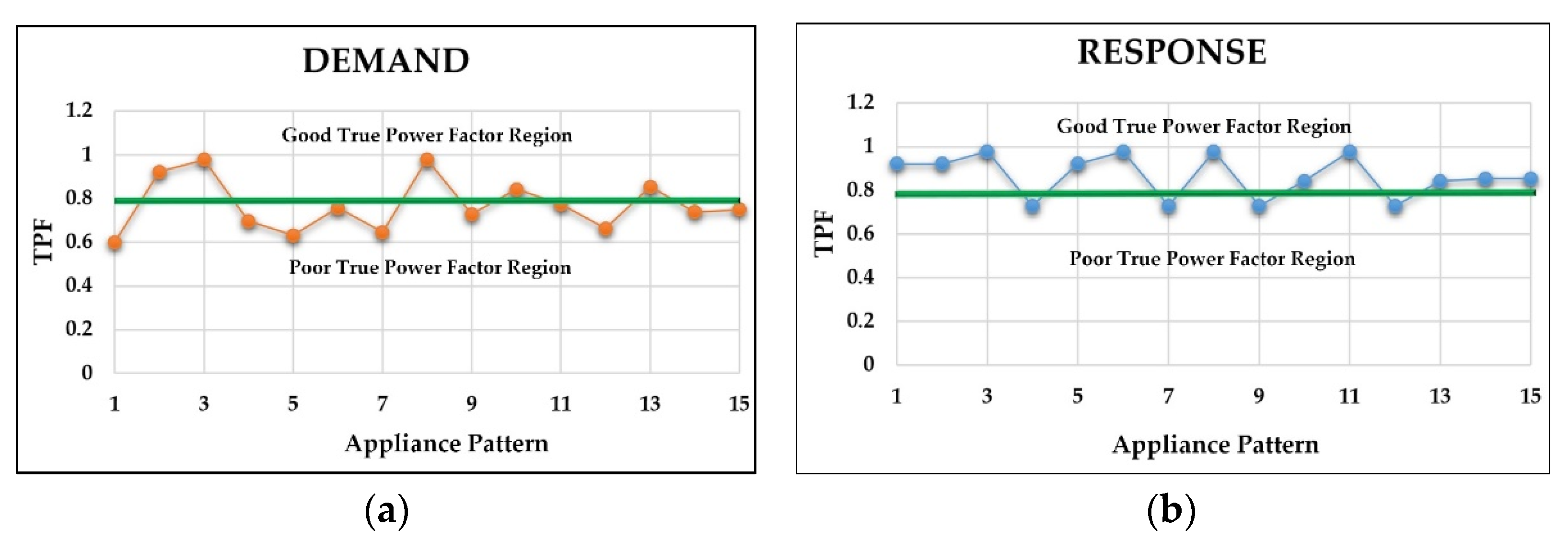
| Standard | Electrical Parameters | Compliance |
|---|---|---|
| IEEE 1459-2010: Standard Definitions for the Measurement of Electric Power Quantities Under Sinusoidal, Non-Sinusoidal, Balanced, or Unbalanced Conditions | Instantaneous Power, Active Power, Reactive Power, Apparent power, Non-Active Power, Voltage THD, Current THD, PF | Yes |
| IEEE 1159-2019: IEEE Recommended Practice for Monitoring Electric Power Quality | RMS voltage, RMS Current, Frequency | Yes |
| IEC 61000-4-60: Testing and measurement techniques—power quality measurement methods | Power Frequency, Flicker, Voltage Magnitude, Unbalance, Harmonics, Interharmonics | Yes |
| S.No | Combinations of Different Appliances | CODE | TPF |
|---|---|---|---|
| 1 | CFL | 1 0 0 0 | 0.59887 |
| 2 | LED | 0 1 0 0 | 0.92228 |
| 3 | Exhaust Fan | 0 0 1 0 | 0.97801 |
| 4 | SMPS of PC | 0 0 0 1 | 0.69738 |
| 5 | CFL + LED | 1 1 0 0 | 0.63145 |
| 6 | CFL + Exhaust Fan | 1 0 1 0 | 0.75781 |
| 7 | CFL + SMPS of a PC | 1 0 0 1 | 0.64612 |
| 8 | LED + Exhaust Fan | 0 1 1 0 | 0.97925 |
| 9 | LED + SMPS of a PC | 0 1 0 1 | 0.72841 |
| 10 | Exhaust FAN + SMPS of a PC | 0 0 1 1 | 0.84232 |
| 11 | CFL + LED + Exhaust Fan | 1 1 1 0 | 0.77422 |
| 12 | CFL + LED + SMPS of a PC | 1 1 0 1 | 0.66289 |
| 13 | LED + Exhaust Fan + SMPS of a PC | 0 1 1 1 | 0.85390 |
| 14 | CFL + Exhaust Fan + SMPS of a PC | 1 0 1 1 | 0.73836 |
| 15 | CFL + LED + Exhaust Fan + SMPS of a PC | 1 1 1 1 | 0.74947 |
| Actionable Insights and Benefits | |||||||
|---|---|---|---|---|---|---|---|
| Demand | Response | Benefits | |||||
| S.No | CODE | TPF | Actionable Insights | S.No | CODE | TPF | Change in TPF% |
| 1 | 1 0 0 0 | 0.59887 | Turn off CFL | 2 | 0 1 0 0 | 0.92228 | −54.0033 |
| 2 | 0 1 0 0 | 0.92228 | NR 1 | NR | 0 1 0 0 | 0.92228 | 0 |
| 3 | 0 0 1 0 | 0.97801 | NR | NR | 0 0 1 0 | 0.97801 | 0 |
| 4 | 0 0 0 1 | 0.69738 | Turn off LED for daytime | 9 | 0 0 0 1 | 0.72841 | −4.4495 |
| 5 | 1 1 0 0 | 0.63145 | Turn off CFL | 2 | 0 1 0 0 | 0.92228 | −46.0574 |
| 6 | 1 0 1 0 | 0.75781 | Turn off CFL | 8 | 0 1 1 0 | 0.97925 | −29.2210 |
| 7 | 1 0 0 1 | 0.64612 | Turn off CFL for daytime | 9 | 0 0 0 1 | 0.72841 | −12.7360 |
| 8 | 0 1 1 0 | 0.97925 | Turn off LED for daytime | 3 | 0 0 1 0 | 0.97801 | 0.1266 |
| 9 | 0 1 0 1 | 0.72841 | NR | NR | 0 1 0 1 | 0.72841 | 0 |
| 10 | 0 0 1 1 | 0.84232 | NR | NR | 0 0 1 1 | 0.84232 | 0 |
| 11 | 1 1 1 0 | 0.77422 | Turn off CFL | 8 | 0 1 1 0 | 0.97925 | −26.4821 |
| 12 | 1 1 0 1 | 0.66289 | Turn off CFL | 9 | 0 1 0 1 | 0.72841 | −9.8839 |
| 13 | 0 1 1 1 | 0.85390 | Turn off LED for daytime | 10 | 0 0 1 0 | 0.84232 | 1.3561 |
| 14 | 1 1 0 1 | 0.73836 | Turn off CFL | 13 | 0 1 1 1 | 0.85390 | −15.6481 |
| 15 | 1 1 1 1 | 0.74947 | Turn off CFL | 13 | 0 1 1 1 | 0.85390 | −13.9338 |
| Standard Deviation | 0.1214 | Standard Deviation | 0.099 | ||||
| Actionable Insights and Benefits | ||||||||||||||
|---|---|---|---|---|---|---|---|---|---|---|---|---|---|---|
| Demand | Response | Benefits | ||||||||||||
| S.No | CODE | P (Watts) | Q (VARs) | S (VAs) | S1 (VAs) | SN (VAs) | Utilization Index = S1/S | S.No | CODE | P (Watts) | Q (VARs) | S (VAs) | S1/S | % Change in Utilization Index |
| 1 | 1 0 0 0 | 89.5377 | −29.0642 | 149.51 | 94.1348 | 116.165 | 0.6296 | 2 | 0 1 0 0 | 8.74502 | −3.1848 | 9.48195 | 0.9815 | 35.8531 |
| 2 | 0 1 0 0 | 8.74502 | −3.1848 | 9.48195 | 9.30684 | 1.8162 | 0.9815 | NR | 0 1 0 0 | 8.74502 | −3.1848 | 9.48195 | 0.9815 | 0 |
| 3 | 0 0 1 0 | 51.0239 | −0.0008 | 52.1708 | 51.0239 | 10.882 | 0.9780 | NR | 0 0 1 0 | 51.0239 | −0.0008 | 52.1708 | 0.9780 | 0 |
| 4 | 0 0 0 1 | 80.2522 | −26.0488 | 115.076 | 84.3726 | 78.2664 | 0.7331 | 9 | 0 0 0 1 | 88.9952 | −29.233 | 122.176 | 0.7666 | 4.3703 |
| 5 | 1 1 0 0 | 98.2871 | −32.2501 | 155.651 | 103.447 | 116.3270 | 0.6646 | 2 | 0 1 0 0 | 8.74502 | −3.1848 | 9.48195 | 0.9815 | 32.2887 |
| 6 | 1 0 1 0 | 140.558 | −29.0638 | 185.479 | 143.53 | 117.481 | 0.7738 | 8 | 0 1 1 0 | 59.7686 | −3.18542 | 61.0348 | 0.9806 | 21.0892 |
| 7 | 1 0 0 1 | 169.803 | −55.1164 | 262.805 | 178.522 | 192.914 | 0.6792 | 9 | 0 0 0 1 | 88.9952 | −29.233 | 122.176 | 0.7666 | 11.3999 |
| 8 | 0 1 1 0 | 59.7686 | −3.18542 | 61.0348 | 59.8534 | 11.953 | 0.9806 | 3 | 0 0 1 0 | 51.0239 | −0.0008 | 52.1708 | 0.9780 | −0.2686 |
| 9 | 0 1 0 1 | 88.9952 | −29.233 | 122.176 | 93.672 | 78.446 | 0.7666 | NR | 0 1 0 1 | 88.9952 | −29.233 | 122.176 | 0.7666 | 0 |
| 10 | 0 0 1 1 | 131.274 | −26.0482 | 155.847 | 133.832 | 79.868 | 0.8587 | NR | 0 0 1 1 | 131.274 | −26.0482 | 155.847 | 0.8587 | 0 |
| 11 | 1 1 1 0 | 149.305 | −32.2485 | 192.844 | 152.747 | 117.728 | 0.7920 | 8 | 0 1 1 0 | 59.7686 | −3.18542 | 61.0348 | 0.9806 | 19.2290 |
| 12 | 1 1 0 1 | 178.533 | −58.2972 | 269.323 | 187.807 | 193.052 | 0.6973 | 9 | 0 1 0 1 | 88.9952 | −29.233 | 122.176 | 0.7666 | 9.0475 |
| 13 | 0 1 1 1 | 140.016 | −29.2325 | 163.971 | 143.034 | 80.1773 | 0.8723 | 10 | 0 0 1 0 | 131.274 | −26.0482 | 155.847 | 0.8587 | −1.5806 |
| 14 | 1 1 0 1 | 220.819 | −55.1134 | 299.063 | 227.59 | 194.049 | 0.7610 | 13 | 0 1 1 1 | 140.016 | −29.2325 | 163.971 | 0.8723 | 12.7595 |
| 15 | 1 1 1 1 | 229.565 | −58.2983 | 306.302 | 236.849 | 194.263 | 0.7732 | 13 | 0 1 1 1 | 140.016 | −29.2325 | 163.971 | 0.8723 | 11.3560 |
| Quantitative Metric Category | Quantitative Metrics | TPF | Statistical Methods |
|---|---|---|---|
| Feature | Sampling rate | Medium | High |
| Method | Process of Execution | Experimental | Empirical |
| Accuracy | Disaggregation percentage (D) | 100 | <100 |
| Disaggregation Error (DE) | 0 | >0 | |
| Precision(P)—TP 1/(TP + FP 2) | 1 | <1 | |
| Recall (R)—TP/TP + FN | 1 | <1 | |
| Accuracy = (TP + TN 3)/(TP + TN + FP + FN 4) | 1 | <1 | |
| F-measure (f1) 2 × P × R/(P + R) | 1 | <1 | |
| Training | User interface | Simple | Complex |
| Real-Time Implementation | Deployment capability | High | Low |
| Scalability | Pace of deployment | High | Low |
| Identification Factor | The standard deviation of the TPF | 0.1271 | NA |
| Generalization | Generalization over unseen homes | High | Medium |
Publisher’s Note: MDPI stays neutral with regard to jurisdictional claims in published maps and institutional affiliations. |
© 2021 by the authors. Licensee MDPI, Basel, Switzerland. This article is an open access article distributed under the terms and conditions of the Creative Commons Attribution (CC BY) license (https://creativecommons.org/licenses/by/4.0/).
Share and Cite
Devarapalli, H.P.; Dhanikonda, V.S.S.S.S.; Gunturi, S.B. Demand-Side Management for Improvement of the Power Quality in Smart Homes Using Non-Intrusive Identification of Appliance Usage Patterns with the True Power Factor. Energies 2021, 14, 4837. https://doi.org/10.3390/en14164837
Devarapalli HP, Dhanikonda VSSSS, Gunturi SB. Demand-Side Management for Improvement of the Power Quality in Smart Homes Using Non-Intrusive Identification of Appliance Usage Patterns with the True Power Factor. Energies. 2021; 14(16):4837. https://doi.org/10.3390/en14164837
Chicago/Turabian StyleDevarapalli, Hari Prasad, Venkata Samba Sesha Siva Sarma Dhanikonda, and Sitarama Brahmam Gunturi. 2021. "Demand-Side Management for Improvement of the Power Quality in Smart Homes Using Non-Intrusive Identification of Appliance Usage Patterns with the True Power Factor" Energies 14, no. 16: 4837. https://doi.org/10.3390/en14164837
APA StyleDevarapalli, H. P., Dhanikonda, V. S. S. S. S., & Gunturi, S. B. (2021). Demand-Side Management for Improvement of the Power Quality in Smart Homes Using Non-Intrusive Identification of Appliance Usage Patterns with the True Power Factor. Energies, 14(16), 4837. https://doi.org/10.3390/en14164837







